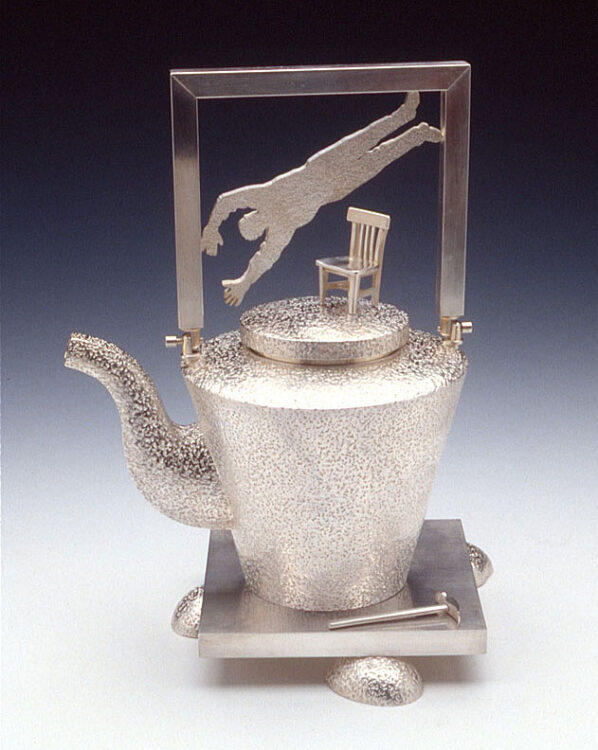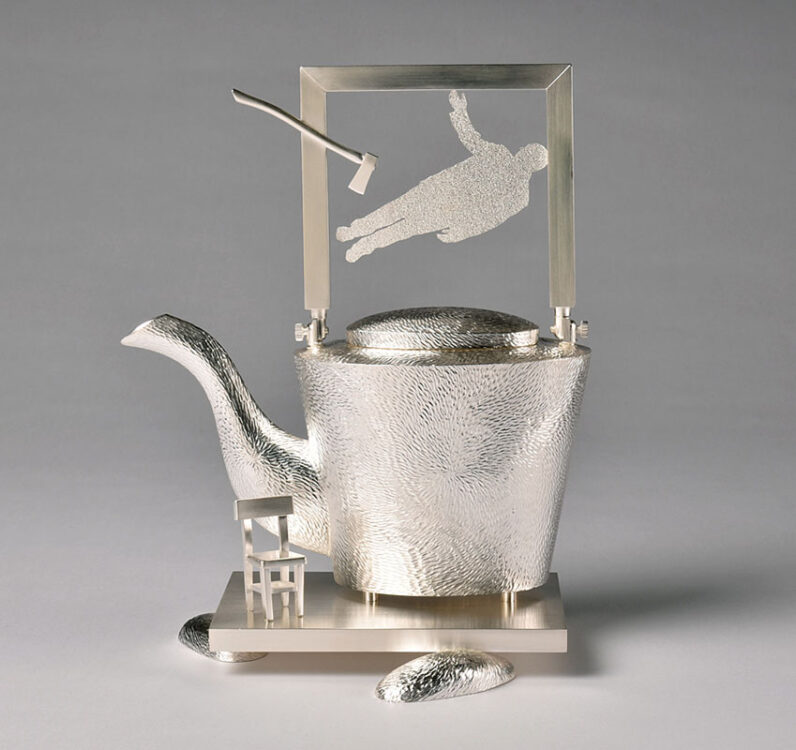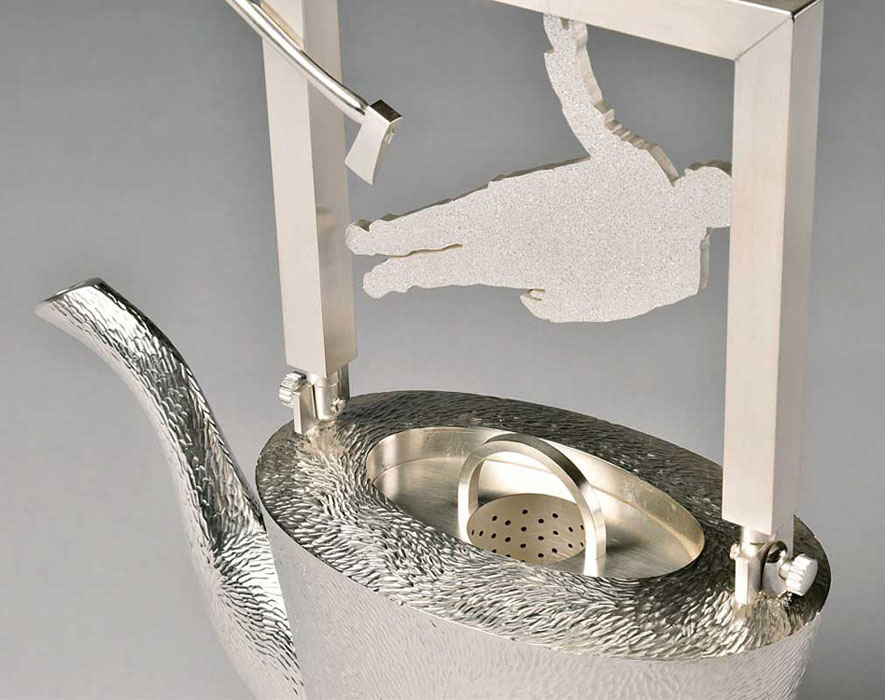The American artist Christina Y. Smith (b. 1951) “[grew] up in a family where tea was important.”[i] She remembers receiving her first tea service at age eight or nine years old, a present from her Scottish grandmother. The sterling silver design, which had a pumpkin theme, was acquired from the impressive London Silver Vaults. Smith’s grandmother wanted her to become familiar with “the traditions” surrounding tea and this gift ensured that she would “be able to pour tea ‘as a young lady should.’”[ii] Until she went off to college, Smith would often be “recruited to serve” at her mother’s bridge parties and luncheons.[iii] While she describes herself in those days as more of “a surfer and skateboarder,” she seems to remember these events with fondness.[iv] Teapots would eventually “conjure up memories of coziness” and when Smith made her first teapot these early “connections” came to mind.[v]
For Smith, teapots would become a vehicle to explore her autobiographical observations.[vi] With “a rare combination of wit and insight,” she often reflects on familiar topics such as “the ordinary joys and sorrows of life” or the “struggle for our own sense of place.”[vii] These matters are addressed in frozen scenes that could be plucked from a play, movie screen, or even a piece of performance art.[viii] Within these scenes, Smith utilizes silhouetted, featureless, textured figures, or “ghost images” as she calls them, along with replicas of everyday objects that “provide visual clues” about the story she is telling.[ix] As you study her work, you sense not just her love of film, but photography as well.[x] “This is particularly evident with her figures. These men and women are intentionally caught “mid-gesture to imply that an action is about to take place.”[xi] Smith wants people to view these scenes she creates and “bring [their] past experiences to the pieces.”[xii]
Smith, who creates both jewelry and holloware, primarily uses sterling silver. Why sterling silver? Smith has an affinity for luxury objects, so it is important that these works are “actually precious” and not “thin or plate.”[xiii] In making this decision she “invokes the gentility of the teapot” and “the materiality of silver with its associations of privilege, wealth, and power.”[xiv]
KAMM TEAPOT COLLECTION
The Kamm Collection has two sterling silver teapots by Smith: Untitled Teapot (Man with Chair) (1996) and Where He Stayed (1997). There is also a tea service called The Ranch (1999). All three of these designs are functional, skillfully built, highly detailed, and incorporate richly textured surfaces.
Untitled Teapot (Man with Chair) was the first teapot Smith ever created. It has an inverted conical body with a flat bottom, a rounded lid with a chair finial, a squared handle featuring a figure, and a tea strainer. Portions of the surface are smooth while other sections have a mottled etched appearance. Untitled Teapot rests upon a rectangular platform which acts as not just a tray, but also a stage setting. Smith has utilized this design element in numerous works including the other examples in the Kamm Collection. The tray is supported by three feet that are meant to resemble semi-submerged granite boulders in water. These forms were influenced by Smith’s interest in flyfishing, a hobby that she was particularly preoccupied with at that time.[xv] Upon the tray lays a claw hammer which, Smith says, “is representative of [her] studio.”[xvi] Above the teapot, within the negative space of the handle, looms the figure. “[Smith] sees herself in this figure” that “[stretches] and [reaches] out in the frame to create an action [or] tension within the space…”[xvii] Under this figure, is the chair finial. Smith frequently utilizes chairs in her work. “It symbolizes a place to sit, but not to rest – [she sees] it as a library chair.”[xviii]

Untitled Teapot (Man with Chair) took about six months to make. It was created for an exhibition at the Los Angeles County Museum of Art (LACMA).[xix] Smith recalls that after Sonny Kamm learned of her new endeavor, he would “insistently” ask her at openings, “where’s my teapot?”[xx] Upon its completion, the Kamms did, of course, acquire the vessel. Because of this early support, Smith credits them for being “partially responsible for the teapot format in her work.”[xxi] From this point onwards, “[her] career [was split] in two directions – as [a] jeweler and as a silversmith”.[xxii]
After finishing her initial teapot, Smith was offered a solo exhibition focusing on teapots at Frank Lloyd Gallery in Santa Monica, California.[xxiii] Where He Stayed was one of six works, all “similar in design and structure,” created for this October 1997 show.[xxiv] This vessel, which also incorporates a mottled etched surface, has an inverted conical body, a domed lid, and a strainer. It sits upon a rectangular tray platform with bolder feet. A miniature axe is attached to its square handle and a detachable diminutive chair is also part of the design. Hovering above the teapot’s lid, Smith included a figure which is diagonally positioned within the square frame of the handle. While this scene feels reminiscent of Untitled Teapot, there is only one arm reaching out with considerably less energy. In fact, in this instance, the individual seems “almost inanimate.”[xxv] This figure “[references Smith’s] partner at the time.”[xxvi] She says, “I was so busy teaching and making and while it seemed my partner was a steadying presence, oddly, my reality was that he was not at all helpful.”[xxvii] For Smith, Where He Stayed is ultimately “about perseverance and about achieving [her] goals.”[xxviii]

The last work in the Kamm Collection is The Ranch, Smith’s first tea service. It was made for the Mobilia Gallery exhibition Teapot Redefined II at SOFA Chicago in November of 1999.[xxix] The set, which has a brushed-like surface, includes a teapot, sugar bowl, creamer, tray, three tea caddies, a sugar cube tray, tongs, a sugar scoop, and a tea strainer. During the design process, Smith made a full-scale model, which she “tweaked” until “the different elements referenced each other and also stood alone visually.”[xxx] All the vessels in this service have squared bodies that flare outwards at the top and bottom. Their handles are square as well. Like the other two teapots in the Kamm Collection, this is a functional tea set. Smith feels that it is imperative that each element performs its required task effectively. For instance, “the [teapot and creamer]…must pour without dripping.”[xxxi]
With The Ranch Smith honors her grandmother Grace who seemed to have a significant impact on her life. Not only did she give her that first tea service, but she also provided her grandchildren with some “incredible childhood adventures.”[xxxii] These adventures occurred, during summers and holidays until Smith was sixteen, on her grandmother’s ranch in Sebastopol, California.[xxxiii] This important place is the inspiration for this service and is directly referenced. For instance, The Ranch’s tea caddies, which also function as the tray’s feet, are meant to represent the outbuildings on the property. Furthermore, within the teapot’s handle, a figure stands upright waiving. This is Smith’s grandmother. She would “[stand] on an elevated porch on the back of the three-story house” and “[call the kids] in from the orchard.”[xxxiv] Smith captures this memory here. On the top of the teapot, her grandmother is waiving to them once again. The figure on the sugar bowl, which is perhaps Smith, seems to raise her arms in response.
The Ranch was completed in just two months and was delivered to SOFA in the nick of time. Smith remembers the excitement of learning the work had been purchased on opening night. After quickly making her way to Mobilia’s booth, she discovered that the Kamms had acquired the work. Smith says, “I can’t even come close to convey how much that meant/means to me.”[xxxv]
BIOGRAPHY
Smith, who is a third-generation Californian, attended San Diego State University, receiving a Bachelor of Arts in 1974 and a Master of Arts in 1979. There she studied metalsmithing with the highly acclaimed jeweler Arline Fisch. In the beginning of her career Smith primarily made jewelry, but then, over time, she expanded her repertoire. Early influences included late 1960s Funk art as well as the work of renowned metalsmith Robert Ebendorf. In 1983 she obtained a third degree, a Master of Fine Arts from California State University, Long Beach. For the past twenty-three years she has taught at California State University, Fullerton.[xxxvi] Smith’s metalwork is included in collections such as LACMA, the Renwick Gallery of the Smithsonian American Art Museum in Washington, DC, and the Museum of Arts and Design in New York.
Further Reading/Viewing:
Benesh, Carolyn L. E., “Irony for the Soul.” Ornament. Autumn 2003. vol.27. no.1.
Christina Smith on her work in Politically Speaking jewelry exhibition. 20 October 2016.
Clark, Garth. The Artful Teapot. New York: Thames & Hudson, Ltd., 2001. (Untitled Teapot (Man with Chair) was included in The Artful Teapot exhibition and the accompanying catalogue.)
Wagle, Kate. “Chris Smith: The Luxury of Stolen Images.” Metalsmith. Spring 1999. vol.19. no.2.
Notes:
[i] https://www.taboostudio.com/articles/cys_ms_sv1.htm, 18 November 2011.
[ii] Email to Allie Farlowe from Christina Smith, 3 February 2024.
[iii] Email to Allie Farlowe from Christina Smith, 3 February 2024.
[iv] Email to Allie Farlowe from Christina Smith, 3 February 2024.
[v] http://www.taboostudio.com/articles/cys_ms_sv1.htm, 18 November 2011.
[vi] Kate Wagle, “Chris Smith: The Luxury of Stolen Images,” Metalsmith, Spring 1999, vol.19, no.2, , 14.
[vii] Carolyn L. E. Benesh, “Irony for the Soul,” Ornament, Autumn 2003, Vol.27, No.1, 33. http://www.taboostudio.com/articles/cys_ms_sv1.htm, 18 November 2011.
[viii] http://www.taboostudio.com/articles/cys_ms_sv1.htm, 18 November 2011.
[ix] Wagle, 17. http://www.silvermag.com/profiles1103.htm, 31 July 2006. For Smith, these ghost images are like an “optical effect that occurs when the light of a projector disappears from the screen.” Wagle, 17.
[x] Wagle, 18.
[xi] Christina Y. Smith Artist Statement, Kamm Teapot Foundation Files, 1999.
[xii] http://www.taboostudio.com/articles/cys_ms_sv1.htm, 18 November 2011.
[xiii] Wagle, 20.
[xiv] Wagle, 20.
[xv] Email to Allie Farlowe from Christina Smith, 3 February 2024.
[xvi] Email to Allie Farlowe from Christina Smith, 3 February 2024.
[xvii] Email to Allie Farlowe from Christina Smith, 3 February 2024.
[xviii] Email to Allie Farlowe from Christina Smith, 3 February 2024.
[xix] She learned about this LACMA exhibition, which never came to fruition, through Garth Clark Gallery in Los Angeles. Encouraged by the gallery’s director Wayne Kuwada, she began making a teapot for the show. Smith was recruited by Garth Clark and Mark Del Vecchio to join the Garth Clark Gallery in the 1980s. She credits Clark, Del Vecchio, and Kuwada for “[propelling her] career onto another level. They introduced [her] to collectors like [Sonny and Gloria Kamm] as well as museum curators and other gallery owners.” Email to Allie Farlowe from Christina Smith, 3 February 2024. Garth Clark would sell the gallery and it would become the Frank Lloyd Gallery. Frank Lloyd Gallery would relocate to Santa Monica, California.
[xx] Email to Allie Farlowe from Christina Smith, 3 February 2024.
[xxi] Letter to Sonny Kamm from Christina Smith. 5 November 2001.
[xxii] Email to Allie Farlowe from Christina Smith, 3 February 2024.
[xxiii] The Frank Lloyd Gallery was established in 1996 in Santa Monica, California.
[xxiv] Email to Allie Farlowe from Christina Smith, 3 February 2024.
[xxv] Email to Allie Farlowe from Christina Smith, 3 February 2024.
[xxvi] Email to Allie Farlowe from Christina Smith, 3 February 2024.
[xxvii] Email to Allie Farlowe from Christina Smith, 3 February 2024.
[xxviii] Email to Allie Farlowe from Christina Smith, 3 February 2024.
[xxix] Mobilia Gallery is in Cambridge, Massachusetts. In 1999 Libby and JoAnne Cooper, the owners of Mobilia Gallery contacted Smith and asked if she considered making a tea service. This is what initiated her work on The Ranch. SOFA, which was the Sculpture Objects Functional Art and Design fair, is now called Intersect Chicago.
[xxx] Email to Allie Farlowe from Christina Smith, 3 February 2024.
[xxxi] Email to Allie Farlowe from Christina Smith, 3 February 2024.
[xxxii] Email to Allie Farlowe from Christina Smith, 3 February 2024.
[xxxiii] Email to Allie Farlowe from Christina Smith, 3 February 2024.
[xxxiv] Email to Allie Farlowe from Christina Smith, 3 February 2024.
[xxxv] Email to Allie Farlowe from Christina Smith, 3 February 2024.
[xxxvi] Smith has also been a lecturer at California State University, Los Angeles, and an instructor at schools such as Cypress College, Cypress, California, Orange Coast College, Costa Mesa, California, and Haystack Mountain School of Crafts, Deer Isle, Maine.
Allie Farlowe is a metalsmith, jeweler, and independent arts writer. Her previous professional experience includes museum work in curatorial and registration departments.


